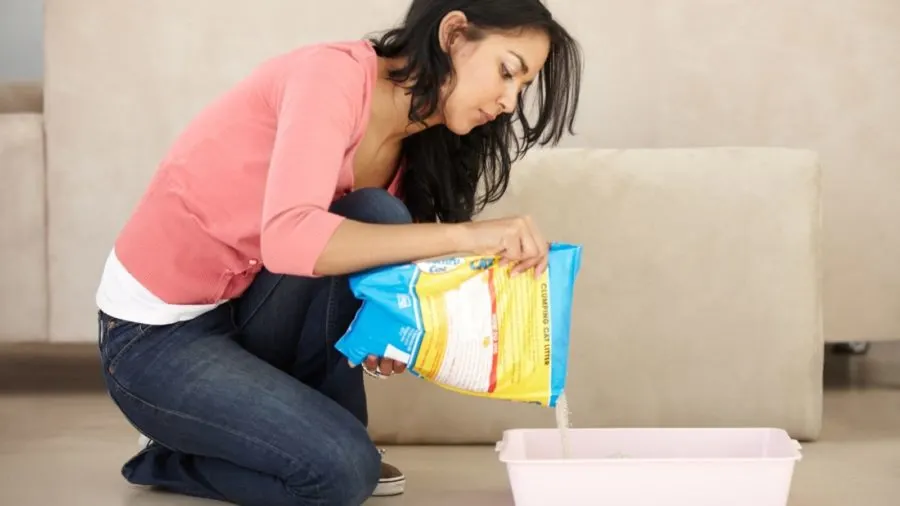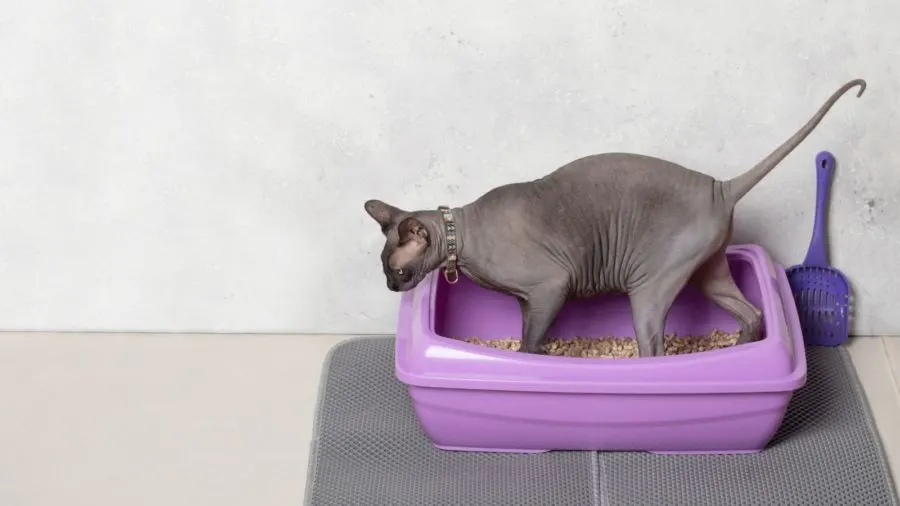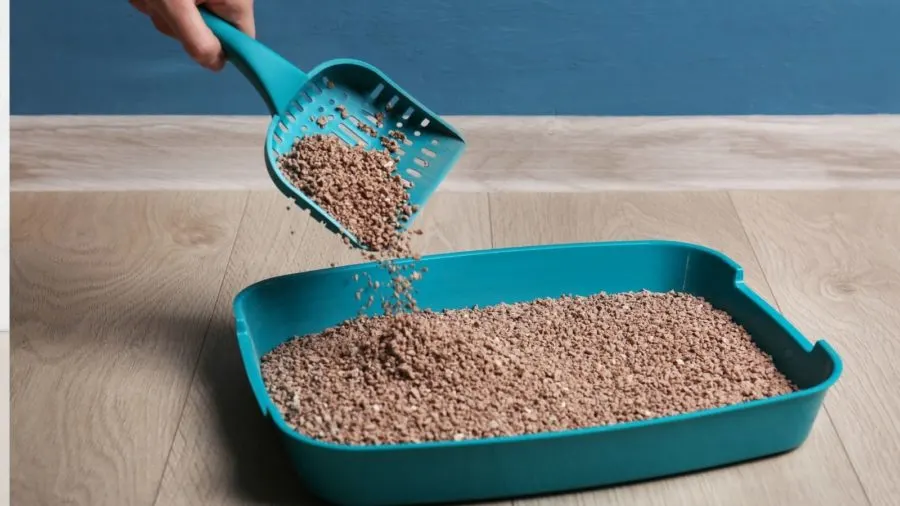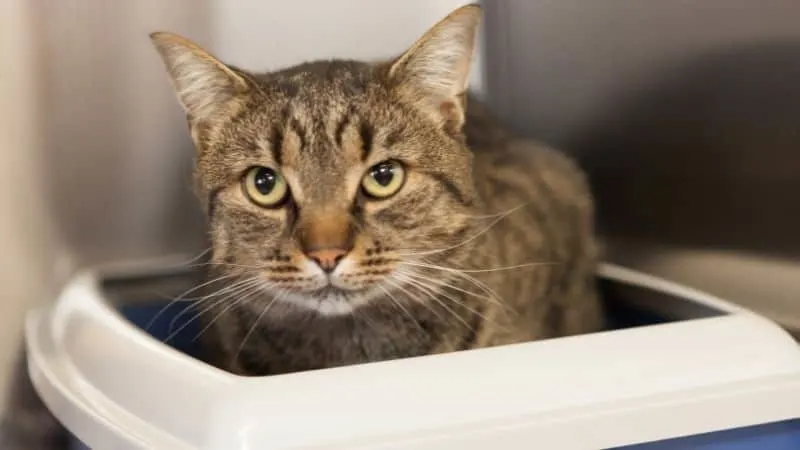Is your cat peeing outside of the litter box? You’re not alone. Inappropriate urination is the most common behavior problem for which cat owners seek assistance–and sadly it’s also a major reason why many cats become abandoned or eventually euthanized.

This post includes affiliate links.
Step One: Rule Out Medical Problems
The first thing you must do for a cat who is urinating/defecating out of the litter box is to eliminate any medical problems.
Your veterinarian should perform a physical examination and urine/fecal tests should be performed.
How to Obtain a Urine Sample From Your Cat
This is really not as difficult as many people think. Here’s how to get a cat urine sample:
- Confine your cat to a small room–bathroom, utility room, laundry room, etc.
- Provide your cat with a clean, empty litter box or fill the bottom with a non-absorbable litter (it looks like plastic pellets and is available from your veterinarian).
- Close the door and wait for nature to take its course.
If your cat does not go within 12 hours, schedule an appointment with your veterinarian as soon as possible.
If you find urine in the box, transfer it as carefully as you can into a clean plastic container or clean pill bottle. Urine can be refrigerated for up to twelve hours.
NOTE: If you have a male cat and he hasn’t urinated in over 24 hours, is acting painful, is vocalizing, or appears to be straining to urinate or defecate THIS IS AN EMERGENCY and you should seek medical treatment as soon as possible. Even if your vet is closed, take him to an emergency facility. His condition will continue to worsen the longer you wait. Not only is this more painful for him, it will cost you more money to have the condition treated.
If your cat does not urinate at home and you’ve made an appointment with the veterinarian, make sure when you take him to the vet there’s nothing on the bottom of the carrier, like a towel or newspaper. That way, if the cat urinates in the box, it will not be absorbed by anything.
If Your Cat Gets a Clean Bill of Health
If nothing is physically wrong with your cat then you are probably dealing with a behavioral problem.
The next step is to determine whether or not your cat is showing signs of inappropriate urination or is marking/spraying.
Is My Cat Peeing Outside the Box or Spraying?
Litterbox problems involve two separate entities: inappropriate elimination (or peeing outside the box) and spraying. Your method for solving the problem depends upon which behavior your cat is performing. So what’s the difference between the two?
Inappropriate elimination mimics what should be taking place inside the litter box. It is defined as peeing outside the box and/or defecating in locations that the owner, not the cat, considers inappropriate.
Some signs of inappropriate elimination are:
- Large amounts of urine as well as feces are found on horizontal surfaces.
- Your cat pees in a squatting position.
- Your cat tries to hide or cover using pawing motions.
- Your cat digs or scratches at surface to prepare for elimination.
Spraying or urine marking is a form of communication. However, it normally is not used to mark a cat’s “territory.” It’s more like leaving a note to your friends and neighbors announcing, “I was here.” Cats also mark using scent glands in their cheeks and paw pads but due to our limited sense of smell we usually aren’t bothered by this type of marking.
Some signs of spraying are:
- Small amounts of urine are found on vertical surfaces. Popular areas are those that lead outdoors such as walls, windows, doorwalls, doorways, etc. Some cats even like to spray on owner’s clothing because they contain scents from the outside world.
- Your cat performs in a standing position.
- Your cat treads with back feet and tail quivers in preparation for spraying.
- More popular with unneutered/unspayed cats but can occur in neutered/spayed cats as well.
It’s important to keep in mind that cats do not urinate inappropriately because they’re “mad” or “trying to get even” with us. When a cat is urinating inappropriately it’s usually because of something very simple that the owner is overlooking.
Solving Inappropriate Urination Problems
OK, you know your cat has an elimination problem. What can you do about it? Usually behavior caused by inappropriate elimination is more easily solved than that caused by spraying, so we’ll tackle that first.
It makes sense that the most common reason cats eliminate outside of the litter box is that there is something about the litter box they don’t like. Studies show that cats have different tastes when it comes to their litterbox so it will benefit you to take the time to figure out what your cat likes best. Cats have different tastes when it comes to:
Litter Type

Most litters today are tested and developed for owners, not cats. The majority of cats seem to prefer an unscented clumping litter.
However, many cats prefer clay litter while others like the sand material found in boxes at playgrounds. Some cats (especially those that spend a lot of time outside) like soil sprinkled on top of their litter.
Litter Depth
Some cats like to dig to China while in their litter box. Other cats prefer little or no litter at all in their litter box. If cleaned frequently, most cats are content to work with only one inch of litter.
The Litter Box Itself
Once again, most litter boxes today are targeted towards the owner’s ease of use, not the cat’s. Most cats prefer a large, uncovered box. Uncovered boxes allow odors to escape (very important for cat) and allow a cat to see if anyone is coming and to escape easily should a sudden ambush occur (important in busy households with kids, dogs, and other cats).
Most litter boxes available in pet stores are too small for many cats. Rubbermaid-type storage containers can offer the cat more room.
High-sided boxes are good for cats who like to dig and are able to get in and out of them easily (bad for old, crippled cats). High-sided boxes are also helpful for cats who like to spray during their visit to the litterbox and for those who urinate in a standing position (yes, some cats do).
Litter Box Location

Many owners fail to choose a proper location for their cat’s litter box. Privacy is important but shouldn’t result in your cat’s litter box being inaccessible. If your cat has to go through an anti-dog obstacle course in order to get to his litter box you are doing him a disservice.
Many owners place their cat’s litterbox in laundry rooms (noisy), or basements and garages (cold, dark, damp). This may be suitable for some cats, but picky cats may find more suitable areas to eliminate.
If you can’t keep your dog out of the litter box you may consider installing a cat door in some area of the house where you would like to place your cat’s litter box. Litter boxes should be in quiet, but easily accessible areas of the house. Some cats are startled by washing machines, dryers, furnaces, etc. and will never return to their litter boxes again.
Where does your cat spend most of his time? It doesn’t make sense to keep your cat’s litter box in the basement if he spends the majority of his time in the second-floor bedroom. Don’t be surprised if your cat chooses another location to eliminate should the urge strike him suddenly.
Cleaning Your Cat’s Litter Box

The first step toward preventing improper elimination is keeping a clean litter box. Litter boxes must be cleaned on a regular basis. If you think the litter box is stinky just imagine how it smells to your cat–their sense of smell is many times more sensitive than ours.
How often should you scoop and clean your litter box?
The box should be scooped at least daily. Boxes with clay litter should be cleaned weekly. Boxes with clumping litter should be cleaned every 10 to 14 days–(this is despite manufacturer’s claims to “just add more litter.” Ignore this advice. This is like saying you don’t have to clean your toilet because it all gets flushed eventually.)
To clean the litterbox, empty completely and wash with unscented dish soap. Rinse and dry well.
If you insist on disinfecting the box add one tablespoon of bleach to the dish soap. Another word of warning: some cats are offended by the scent and feel of baking soda when it is added to their litter.
Also make sure that you don’t have any air fresheners hanging out near your cat’s litter box. If may smell good to you, but it doesn’t smell good to your cat. In fact, some cats will dislike the smell so much that they’ll choose another place to eliminate so they don’t have to deal with it. Citrus odors like orange and lemon seem to be the most offensive for some reason.
Your cat’s litterbox does not need to be an offending object. Regular cleaning will make everyone’s noses happy. You also needn’t waste a fortune in litter by cleaning the box on a weekly basis. The litter only needs to be an inch deep if the box is cleaned frequently.
Is Your Litter Box Hurting Your Cat?
There may be other causes for your cat to eliminate outside of the litter box. Some cats associate the litter box with pain. This is usually caused by some medical condition that made elimination painful or from digging sore paws in the litter box after declawing.
There may also be some reason why the cat is unable to go to the litter box. Perhaps on its way to the litter box it is being bullied by a cat, dog, or child. Eliminating in another area is preferable to an encounter with the bully. Finding a more suitable location for your cat’s litter box would be the solution in this case.
How Many Litter Boxes Should I Have?

To avoid inappropriate elimination in multi-cat households, the best rule-of-thumb is to have one litter box per cat plus one.
This is not so each cat can have his/her own private box, but to increase the chances that a clean box will be available.
Separate and spread the boxes throughout the household. It doesn’t make sense to have all the boxes stored in one area. This also helps to avoid ambushes between cats that don’t along. There’s nothing worse than getting attacked on your way to the bathroom!
How to Stop Your Cat From Spraying
Housesoiling becomes a bit more complicated when spraying is involved. Spraying increases from 25% in single-cat households to 100% in households with more than 10 cats. Males and females that are not spayed or neutered will exhibit this behavior more frequently than those who are.
To avoid spraying first determine, if you can, which cat is responsible. You may want to put the cat’s food bowl in the area where he/she is fond of spraying. You can also place a scent deterrent (mint, air freshener or anything you know the cat dislikes) near the sprayed area.
The presence of outside cats is also an inciting cause for urine marking inside the home. It should also go without saying that your first line of defense against cats spraying in your household is to have them all spayed or neutered.
- 🎉 GIVEAWAY: Lord of the Pets Portrait of Your Cat! - November 26, 2024
- Review: Lord of the Pets Cat Portraits! - November 26, 2024
- Cat Adoption: FAQ You Might Have - June 28, 2024
